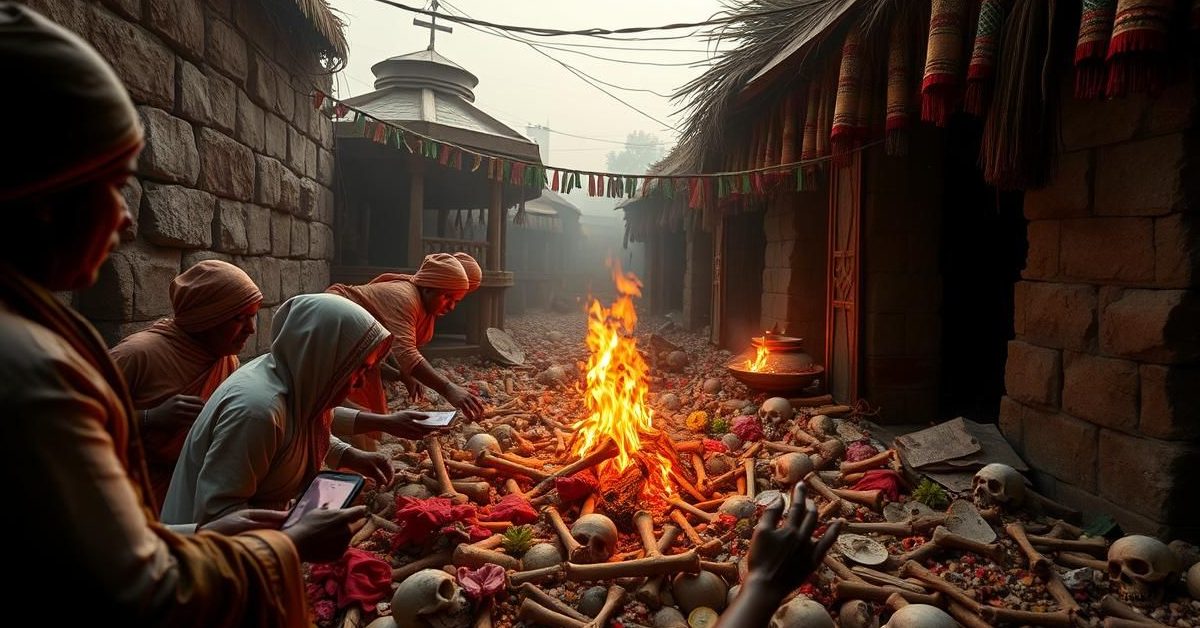India’s funeral practices are a rich tapestry of beliefs and traditions, reflecting diverse cultural histories, faiths, and interpretations of the afterlife.
Beliefs Shape Burial
How cultures imagine the afterlife profoundly influences their funeral rites. Those who believe in a single life often inter bodies in tombs, marking sites with gravestones. Conversely, those who believe in rebirth often return the body to nature, through cremation, water burial, or even exposure.
A prime example is the Ahom kings of Assam. Originally from China via Southeast Asia, they buried their dead in mounds called Moidams, sometimes even with attendants. After converting to Hinduism, they adopted cremation, casting bones into rivers to facilitate rebirth. This shift highlights how evolving beliefs lead to changing customs.
Ancient Rites: From Pots to Megaliths
Prehistoric and Harappan Traditions
In prehistoric times, pots were crucial for burials. People either buried the deceased directly within pots (primary burials) or placed bones after cremation inside them (secondary burials). Ancient Tamil Sangam poetry even speaks of widows requesting large pots for their deceased husbands.
South India also features ‘cists,’ stone-lined pits used for burials. The Harappan civilization practiced both cremation and burial, with some burial sites containing minimal goods like beads and pots. Interestingly, Dholavira has burial mounds without bodies, possibly commemorating those who died far from home.
Iron Age and Vedic Practices
The Deccan region’s Iron Age (1000 BC) is marked by megalithic burial sites, distinct from the contemporary Vedic culture thriving in the Ganga-Yamuna basin. These sites often feature ‘dolmens’ – two vertical stones topped with a horizontal capstone – beneath which bones and food offerings were placed.
The Vedas themselves mention both cremation and burial. Epic tales like the Ramayana and Mahabharata describe cremation for figures such as Dasharatha and Ravana. Post-funeral rituals often involved feeding the ‘Pitr’ or ancestors.
While cremation was common among upper castes who could afford firewood, many lower-caste communities continued pre-Vedic burial practices. These burials often occurred in family-owned fields, signifying ownership and lineage.
Sacred Sites: Stupas, Samadhis, and Memorial Stones
Across India, individuals from religious communities, particularly saints, were sometimes buried in a seated position, reflecting a belief that they would not be reborn. Hindu monasteries often buried saints this way, planting a sacred tulsi plant above the grave in a special pot.
Jain monks might have a tree planted or a stupa built over their graves. Buddhists also built stupas over the bones of cremated monks, a practice that led Vedic people to sometimes view them as “worshippers of bones.” Buddhist sites of burial or bone relics were called Stupas, while Hindu and Jain equivalents were known as Samadhis.
Beyond religious figures, sepulchre shrines marked burial or cremation sites, with some Chola kings even placing Shivlings there. In regions like Rajasthan and Gujarat, ‘hero stones’ commemorated warriors who died defending their villages. ‘Sati stones’ marked spots where women self-immolated on their husbands’ pyres, and ‘Nishidhi stones’ in Karnataka honored Jain sages who fasted to death.
Islamic Influence and Rajput Adaptations
The tradition of building monumental tombs in India began after the 10th century AD with the arrival of Islamic culture, though tomb-building itself originated in Central Asia, not Arabic practice. This led to iconic structures like the tombs of the Khiljis, Tughlaqs, Lodis, Suris, and most famously, the Mughal monuments, including the Taj Mahal. Burial sites of Sufi saints also became significant pilgrimage destinations.
Observing this Muslim practice, many Rajput rulers began constructing ‘Chattris’ – cupolas and pavilions – at royal cremation sites from the 13th to the 19th centuries. This practice spread to Maharashtra and Gujarat. Even today, sites where political leaders are cremated are often marked with ‘samadhis,’ a custom that, ironically, runs counter to the traditional Vedic belief of leaving no trace of the dead to facilitate rebirth.
Unique Tribal Practices
Some tribal communities, like the Monpa in Northeast India, have highly unique funeral rites. They may cut the deceased’s body into 108 pieces and cast them into rivers for consumption by fish. This diverse array of funeral monuments and practices across India offers profound insights into the country’s varied religious beliefs and cultural histories.
- Funeral practices in India are deeply shaped by beliefs about the afterlife, leading to diverse methods like burial, cremation, or exposure to nature.
- Ancient traditions included pot burials, stone-lined pits, and megalithic structures, predating or coexisting with Vedic practices.
- The arrival of Islamic culture introduced monumental tomb-building, which in turn influenced Rajput rulers to construct ‘Chattris’ over cremation sites.
- Specialized memorial stones like ‘hero stones’ and ‘sati stones’ mark sites of valor or sacrifice, highlighting local traditions.
The study of these customs reveals a dynamic interplay of indigenous traditions, religious conversions, and foreign influences that have shaped India’s rich cultural landscape over millennia.















